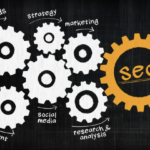In the fast-paced realm of B2B digital marketing, staying ahead of the curve is paramount to success. Strategies and channels that deliver the best results are constantly evolving, with various channels vying for attention and supremacy. As we continue into 2024, it’s time to look at the most potent B2B marketing channels for reaching your business audience.
In this blog post, we’ll explore strategies and platforms currently making waves, providing you with insights to help navigate the dynamic world of B2B marketing and maximize your outreach and impact.
Whether you’re a seasoned pro or just starting to explore B2B marketing, this guide will provide you with essential insights to stay at the forefront of the competition. Join us as we uncover the most effective B2B marketing channels in 2024!
. . .
Contents
. . .
The Most Effective B2B Marketing Channels in 2024
Content Marketing

B2B content marketing plays a pivotal role in today’s digital landscape, serving as a linchpin for businesses and brands looking to connect with their audience in a meaningful way. It has the ability to educate, inspire, and captivate, fostering a deep sense of trust and loyalty among consumers.
Through well-crafted content, B2B businesses can guide prospects through the buyer’s journey, addressing their evolving needs at every stage and ultimately driving conversions. This approach not only establishes authority in the industry but also forges lasting connections, making content marketing an indispensable tool for B2B marketing channels.
Here are 8 of the most impactful B2B content marketing channels in the current landscape:
- B2B Video Content: Video remains a versatile and compelling way to convey complex B2B concepts and engage audiences. Webinars, product demonstrations, and explainer videos are popular choices that can be shared on social media platforms to maximize reach.
- Podcasts: Podcasts offer an audio medium for in-depth discussions, interviews, and sharing insights on industry-specific topics. They cater to on-the-go professionals, making them an excellent channel for multitasking listeners. This is a great area for you to showcase your expertise in your industry.
- Infographics: Visual content is great for simplifying complex ideas and making data more accessible and shareable. They’re an excellent choice for conveying statistics and key insights succinctly.
- Forums and Communities: Participating in online forums, discussion boards, or industry-specific communities is a way to share expertise and connect with a target audience. These channels foster direct engagement and help establish thought leadership within niche communities.
- Webinars and Live Streaming: Hosting webinars and live streaming can attract and engage a targeted B2B audience, positioning your brand as an expert. This allows for real-time interaction and Q&A sessions, fostering deeper engagement and trust.
- Blogs: Well-written and informative blog posts are a staple of content marketing, providing a platform to share industry expertise and establish authority. They offer opportunities for engagement through comments and discussions and can be optimized for SEO.
- Whitepapers and Ebooks: In-depth, research-driven content pieces can be powerful tools for lead generation and showcasing industry knowledge. Often gated behind forms, they collect valuable lead information for future marketing efforts while delivering comprehensive insights.
- Case Studies: Detailed case studies showcasing successful collaborations with clients provide social proof and demonstrate expertise. They offer a storytelling approach, which can resonate deeply with potential customers seeking evidence of value.
Remember, the most effective medium may vary based on your target audience, industry, and the goals of your content marketing strategy. It’s essential to analyze the preferences and behaviors of your specific audience to tailor your strategy accordingly.
Search Engine Optimization

Search engine optimization (SEO) is an essential component of B2B marketing channels, serving as a foundational element for driving organic traffic to websites.
This strategic approach involves the meticulous optimization of content and web pages to secure higher search engine rankings, ultimately enhancing a website’s visibility and making it more accessible to users actively seeking information, products, or services related to specific industries and topics.
Here are the 12 more important things to consider for B2B SEO:
- Quality Content: Producing high-quality, informative, and engaging content that satisfies user intent and answers their questions is at the core of effective SEO. Content should be well-researched, original, and relevant to your target audience.
- Keyword Research: In-depth keyword research is critical for identifying the terms and phrases users are searching for. Incorporate relevant keywords naturally into your content to improve search visibility.
- On-Page Optimization: Ensure on-page elements like title tags, meta descriptions, headings, and image alt tags are optimized with relevant keywords and are user-friendly.
- Mobile Optimization: With the increasing use of mobile devices, having a responsive and mobile-friendly website is essential for SEO.
- Page Speed: Fast-loading web pages provide a better user experience and can positively impact search rankings. Optimize images, use browser caching, and employ Content Delivery Networks (CDNs) to improve page speed.
- Technical SEO: Technical aspects such as site structure, URL structure, and canonical tags play a significant role in SEO. Ensure that your site is accessible and indexable by search engines.
- Backlinks: High-quality backlinks from authoritative and relevant websites can significantly boost your site’s authority and rankings. However, focus on natural link-building strategies to avoid penalties.
- User Experience (UX): An intuitive and user-friendly website design is essential for both user satisfaction and SEO. A good user experience can reduce bounce rates and improve rankings.
- Local SEO: For businesses with a physical presence, optimizing for local search is vital. Claim and optimize your Google My Business listing, encourage customer reviews, and ensure NAP (Name, Address, Phone) consistency.
- Schema Markup: Adding schema markup to your content can provide search engines with more context about your content, which can result in rich snippets in search results.
- Voice Search Optimization: As voice search continues to grow, optimizing for voice search queries can be beneficial. This involves using natural language and providing concise answers.
- Content Updates: Regularly update and refresh your existing content to keep it relevant and valuable. This can also improve search rankings.
It’s important to note that SEO is an evolving field, and search engine algorithms change regularly. Staying up to date with the latest trends and algorithm updates is crucial for maintaining a strong SEO strategy. Consider consulting B2B SEO experts or following reputable SEO blogs and news sources for the most current information and techniques.
Email Marketing

Email remains a reliable and powerful tool for reaching and engaging through B2B marketing channels. It provides a direct, personalized, and cost-effective means of communication. With carefully crafted content, businesses can nurture leads, maintain customer relationships, and deliver tailored messages to specific segments of their audience.
Moreover, email marketing allows for tracking and analysis, providing insights into the performance of campaigns and enabling continuous improvement. As a cornerstone of B2B marketing, the enduring effectiveness of email ensures that it continues to be a linchpin for businesses in fostering connections, generating leads, and ultimately driving conversions.
Here are 10 effective email marketing techniques for engaging subscribers and achieving your goals:
- Segmentation: Divide your email list into specific segments based on characteristics like demographics, behavior, or engagement level. This allows for highly targeted messaging.
- Personalization: Address subscribers by their name and customize email content to their preferences and needs, creating a more personalized experience.
- A/B Testing: Experiment with different elements of your emails, such as subject lines, content, images, and calls to action, to discover what resonates best with your audience.
- Automated Workflows: Implement automated email workflows or drip campaigns to send a series of emails triggered by user actions, nurturing leads, or guiding customers through a journey.
- Valuable Content: Provide content that offers value, such as educational resources, industry insights, or exclusive offers, to keep subscribers engaged and interested.
- Mobile Optimization: Ensure that your emails are mobile-responsive, as many people check their emails on mobile devices. A mobile-friendly design is essential for a positive user experience.
- Social Proof: Incorporate elements like customer testimonials, reviews, and case studies to build trust and credibility with your subscribers.
- Clear Call-to-Action (CTA): Include compelling CTAs that guide subscribers toward the desired action, whether it’s downloading content, making a purchase, or scheduling a demo.
- Data Analysis: Regularly analyze email campaign performance using metrics like open rates, click-through rates, and conversion rates. Use the data to refine your email strategy.
- Compliance: Adhere to email marketing regulations, such as GDPR or CAN-SPAM, to ensure legal and ethical email practices, which helps build trust with subscribers.
These techniques can help you create engaging and effective email marketing campaigns that resonate with your subscribers and drive the desired actions, whether it’s lead generation, nurturing, or sales.
Social Media Marketing

Leveraging social platforms for B2B audiences is a strategic move in today’s digital landscape, particularly in the realm of B2B marketing channels. While social media is often associated with consumer-focused marketing, it plays a vital role in B2B interactions.
These platforms are not just spaces for networking but also serve as a source of valuable insights, allowing B2B companies to understand market trends, connect with decision-makers, and nurture leads.
Businesses can harness platforms like LinkedIn, Twitter, Instagram, YouTube, and Facebook to build industry authority, foster connections, share valuable content, and engage in meaningful discussions, making them integral B2B marketing channels.
In addition to utilizing content marketing techniques on social media, here are 8 effective social media marketing techniques to apply in 2024:
- Personalization: Build relationships with your followers and connections by engaging with them directly. Respond to comments and messages, and show a personal touch in your interactions.
- Paid Advertising: Utilize paid advertising options on platforms like LinkedIn and Twitter to target specific B2B audiences with your content and generate leads.
- Employee Advocacy: Encourage your employees to share company content and become advocates for your brand. This can significantly extend your reach and enhance credibility.
- Influencer Marketing: Collaborate with industry influencers or experts to amplify your brand’s reach and credibility. Influencers can promote your content or provide guest contributions.
- Email Capture: Use social media to drive traffic to landing pages where you can capture email addresses for lead nurturing. An email list is crucial for B2B marketing.
- Hashtag Usage: Use relevant hashtags to increase the visibility of your content, especially on platforms like Twitter and Instagram.
- Social Listening: Monitor social media conversations to identify trends and topics that matter to your audience. This can help you create more relevant content.
- Analytics and Monitoring: Regularly analyze social media metrics to track engagement and adjust your strategy accordingly. Tools like Hootsuite and Buffer can help with scheduling and monitoring.
These techniques can help you effectively engage with your B2B audience, build relationships, and drive lead generation through social media marketing. Remember to adapt your strategies to your specific goals, industry, and target audience while staying updated with the latest trends and best practices in social media marketing.
Account-Based Marketing

Account-based marketing (ABM) is a cornerstone in the realm of B2B marketing channels, crucial for personalized engagement. This strategic approach targets high-value accounts with personalized content by focusing resources on specific accounts or industries. It also enables businesses to align marketing and sales teams, driving more qualified leads, shorter sales cycles, and higher conversion rates.
ABM fosters stronger customer relationships and maximizes ROI by tailoring content and solutions to the unique needs and pain points of key accounts. In a competitive B2B landscape, where precision and personalization matter, ABM stands out as a powerful B2B marketing channel for driving growth and revenue.
Here are 10 effective ABM techniques aimed to personalize marketing efforts and drive growth:
- Account Selection: Identify and prioritize high-value target accounts based on factors such as revenue potential, industry, and fit with your ideal customer profile (ICP).
- Personalized Content: Develop highly personalized content tailored to the specific needs and pain points of each target account. This can include custom messaging, case studies, and industry-specific insights.
- Multi-Channel Outreach: Utilize a mix of marketing channels such as email, social media, direct mail, and advertising to reach target accounts through multiple touchpoints.
- Marketing Automation: Use marketing automation tools to deliver personalized content and messages at scale while maintaining a personalized feel.
- Sales and Marketing Alignment: Ensure close collaboration between sales and marketing teams. Sales can provide valuable insights and feedback on target accounts, while marketing can create tailored campaigns.
- Data and Analytics: Leverage data and analytics to understand how target accounts engage with your content and campaigns. Use this data to refine your approach.
- Direct Mail: Send personalized, physical marketing materials to key decision-makers in target accounts. This can leave a lasting impression and set you apart from competitors.
- Influencer Marketing: Collaborate with industry influencers and thought leaders to gain access to their networks and establish credibility with target accounts.
- ABM Software: Use specialized ABM software platforms that provide tools for account identification, content personalization, and tracking engagement.
- Regular Reporting and Optimization: Continuously monitor and analyze the performance of ABM campaigns. Adjust your strategies based on the data to improve effectiveness.
To succeed in the realm of B2B marketing channels, effective ABM techniques require a deep understanding of your target accounts and a commitment to personalization and engagement. By tailoring your approach to the unique needs and characteristics of each account, you can build stronger relationships and drive revenue growth.
Search Engine Marketing & Pay-Per-Click Marketing

B2B Search engine marketing (SEM) and pay-per-click (PPC) advertising are integral B2B marketing channels. Both have become vital tools for businesses of all sizes that deliver immediate and targeted results.
SEM is the overarching strategy that encompasses various online marketing methods, including PPC. SEM involves optimizing websites and running paid ads on search engines (like Google) to increase visibility and drive traffic. It offers the potential to capture the attention of users actively seeking products or information.
PPC, however, is a specific advertising model within SEM, that allows you to reach specific demographics and interests with precision. With PPC, you pay only when someone clicks on your ad, enabling a level of budgetary control that few other advertising methods can match. This makes it accessible for businesses with varying budgets.
Here are 10 effective SEM and B2B PPC techniques to further improve your targeting, engagement, and overall campaign efficiency in 2024:
- Keyword Research and Optimization: Continually research and refine your keywords to align with search intent. Focus on long-tail keywords and consider voice search trends.
- Ad Extensions: Utilize ad extensions to provide additional information and encourage clicks. These extensions include site link, callout, and structured snippet extensions.
- Remarketing: Implement remarketing campaigns to re-engage users who have previously visited your website but didn’t convert—tailor ads to their specific interests.
- Audience Targeting: Leverage audience targeting to reach users based on demographics, interests, behaviors, and previous interactions with your website.
- Negative Keywords: Regularly update your negative keyword list to filter out irrelevant traffic and improve click-through rates.
- Ad Copy Optimization: Create compelling ad copy that aligns with user intent and encourages clicks. Use ad copy A/B testing to refine your messaging.
- Video Advertising: Consider video ads on platforms like YouTube to engage with your audience through informative or entertaining content.
- Responsive Search Ads (RSA): Experiment with RSA to test multiple ad variations and let Google optimize for the best-performing combinations.
- Conversion Tracking: Implement conversion tracking to measure the success of your campaigns and identify areas for improvement.
- Budget Allocation: Carefully allocate your budget to campaigns that show the best ROI potential. Monitor and adjust budgets based on performance data.
Keep in mind that the SEM and PPC landscape is dynamic, so regularly stay informed about updates from Google Ads, Bing Ads, and social media advertising platforms. Additionally, consider consulting with B2B PPC experts and following industry blogs for the latest effective techniques and strategies.
Trade Shows & Events

In 2024, the resurgence of in-person and virtual events underscores the adaptability and innovation of the trade show and events industry in the B2B marketing channels landscape.
As the world continues to navigate uncertainties, the flexibility and inclusivity offered by hybrid events provide a balanced approach, ensuring that businesses can connect, engage, and grow with their audiences in ways that best suit them. In this new era of B2B marketing, leveraging both in-person and virtual events can be a powerful strategy for growth and connection.
Here are 5 techniques that can be used for in-person trade shows and events:
- Booth Design and Engagement: Create an eye-catching booth that invites attendees to engage with your brand through interactive displays, product demos, and engaging visuals.
- Live Demonstrations: Conduct live product demonstrations to showcase your offerings and allow attendees to experience them firsthand.
- Networking and Relationship Building: Encourage your team to proactively network with event attendees, fostering valuable relationships and generating leads.
- Promotional Items: Offer branded promotional items, giveaways, or event-exclusive discounts to attract attendees to your booth and create memorable brand associations.
- Content Marketing: Share physical copies of industry insights, whitepapers, or informative content (e.g. brochures and pamphlets) to position your brand as an authority in your field and capture attendees’ interest.

Here are 5 effective techniques that can be used for virtual trade shows and events:
- Virtual Booths: Design a virtual booth that mirrors the look and feel of a physical one, complete with engaging multimedia content.
- Webinars and Virtual Demos: Conduct live webinars or virtual product demonstrations to engage attendees in real time.
- Chat and Messaging: Utilize live chat and messaging features to interact with attendees, answer questions, and provide personalized information.
- Lead Scoring and Tracking: Implement digital lead scoring and tracking to monitor attendee engagement and identify high-potential leads.
- Content Sharing: Share downloadable content, such as ebooks, infographics, and videos, to provide value and gather attendee contact information.
By leveraging these techniques in both in-person and virtual trade shows and events, businesses can effectively engage with their target audience, generate leads, and build valuable relationships within their industry.
Referral & Networking Marketing

The significance of referral and networking marketing cannot be overstated. These strategies are firmly anchored in trust and human connections, serving as pillars of credibility in a digital landscape.
Referral marketing harnesses the power of satisfied clients and partners, delivering high-quality leads and fostering a sense of authenticity. Networking marketing, on the other hand, expands your professional horizons, offering opportunities for knowledge exchange and relationship-building within your industry.
Both these techniques thrive on the personal touch, emphasize the enduring importance of trust, and remain indispensable tools in the B2B marketing channels arsenal.
Here are 5 referral marketing techniques that have been effectively used to develop trust and foster connections in 2024:
- Customer Referral Programs: Establish formal referral programs that incentivize existing clients to refer your business to their network, offering rewards, discounts, or exclusive access.
- Referral Software: Implement referral software platforms that streamline the referral process, making it easier for customers to refer others and for you to track and reward referrals.
- Engaging Content: Create shareable and engaging content that encourages clients to naturally recommend your products or services to their peers.
- Personalized Outreach: Send personalized requests for referrals, tailoring your message to the individual and highlighting the value they’ve received from your business.
- Follow-Up: Promptly acknowledge and thank referrers for their recommendations, strengthening the relationship and encouraging further referrals.

Here are 9 networking marketing techniques for effective relationship-building:
- Industry Events: Attend relevant industry events, conferences, and seminars to connect with professionals, share knowledge, and explore potential partnerships.
- Online Communities: Engage in online forums, social media groups, and industry-specific communities where you can share insights, answer questions, and connect with like-minded individuals.
- Webinars and Workshops: Host webinars or workshops on industry topics to position your brand as an authority and attract professionals looking for valuable information.
- LinkedIn Outreach: Leverage LinkedIn for professional networking. Connect with industry peers and initiate conversations that lead to meaningful collaborations.
- Professional Associations: Join and actively participate in professional associations related to your industry, which often provide opportunities for networking and partnership building.
- Collaborative Projects: Seek opportunities for collaborative projects or partnerships with complementary businesses, expanding your network and clientele.
- Email Marketing: Use email as a tool for reaching out to connections with updates, insights, or collaboration proposals.
- Content Sharing: Share valuable content, such as industry reports, articles, or thought leadership pieces, with your network to showcase your expertise.
- Follow-Up and Nurturing: Maintain relationships by following up with connections, providing support, and nurturing partnerships over time.
Both referral and networking marketing rely on building and maintaining authentic relationships. In 2024, these techniques remain effective as they adapt to digital tools and platforms, emphasizing trust and human connections in the B2B marketing channels landscape.
. . .
Conclusion
As we wrap up our exploration of the most effective B2B marketing channels in 2024, it’s abundantly clear that the landscape is dynamic, diverse, and teeming with opportunities. From the enduring power of content marketing to the invaluable role of data-driven strategies, businesses have a vast array of tools at their disposal. Their ability to adapt, evolve, and innovate sets the most successful ventures apart.
In this digital era, the fusion of tried-and-true methods with cutting-edge techniques is the recipe for sustainable success. These 2024 B2B marketing channels offer a tapestry of choices, but it’s the art of weaving them together effectively that separates the leaders from the followers.
The key lies in embracing the diverse toolkit that 2024 offers, forging connections, harnessing data, and delivering value to customers—ultimately securing a brighter future for B2B marketing.
. . .
If you enjoyed reading content like this, feel free to check out the other blogs on our website. For more information on how to best utilize B2B marketing channels to maximize your business growth, you can reach out to us for a free consultation. We’d love to get you started on your Synthesis Insights journey today!




